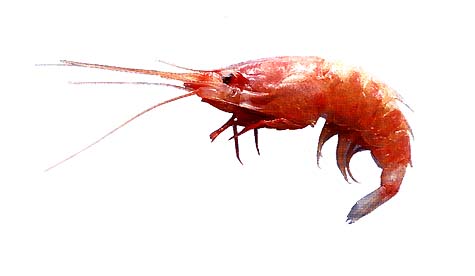ヒオドシエビ科(Oplophoridae)

トゲオキヒオドシエビ
Oplophorus gracilirostris A. Milne Edwards, 1881
特 徴:
体長5cm。頭胸部は左右に強く側扁され,背面の正中隆起が鋭い。側面にとげはないが,触角上棘から水平な溝が頭胸甲長の1/3ほど走る。その溝はごく浅くなって上方へ湾曲し,頭胸甲後縁の突起部に達する。前側角は角ばり,側方に向くため,背面から見ると頭胸甲が横に広がっている。額角は頭胸甲長にほぼ等しく,上方に弱く湾曲する。上縁には眼窩底部より前方に10本ほどの,下縁には6〜8本のとげが等距離に並んでいる。額角の基部1/3は幅広く,背面から見るとこの部分から先が急に細くなっている。広い部分には額角側溝および側隆起が明瞭で,後方は頭胸甲の中央部に達する。触角鱗は大きく,外縁に小さなとげが並ぶ。第1,2胸脚にはさみをもち,胸部付属肢はすべて胸甲の下におさまる。第3〜5腹節の背縁後端は鋭いとげとなって後方に突出する。尾節は細長く,鋭くとがる。
採集記録:
水深348〜810m(多数)。
分 布:
従来の記録はメキシコ湾,西インド諸島およびアラビア海から日本,ハワイ。水深100〜2,400m。
備 考:
ごく近縁のO. spinosus(Brullé)からは頭胸甲の後側角にとげ状歯があることで容易に区別される。
Diagnostic characters:
Carapace compressed, with dorsal strong carina; a transverse furrow from antennal spine, about one-third as long as carapace, continuing posteriorly as an upward-curved faint furrow to angular portion of posterior margin of carapace; anterolateral angle acute and dilated laterally; a spine at posterolateral angle. Rostrum about as long as carapace, curving gently upward; about ten equidistant spines on upper margin anterior to base of eye, and six to eight spines on lower margin; basal one-third of rostrum wide and ornamented with a longitudinal furrow at each side which is delimited by a sharp lateral carina and extended posteriorly just to median part of carapace. Chelate first two pairs and other pereiopods folded beneath thoracic sternite. Posterior dorsal ends of third to fifth abdominal segments produced each to be a sharp spine.
Distribution:
Previously known from the Gulf of Mexico and the West Indies in the West Atlantic, and the Indo-West Pacific from the Arabian Sea to Japan and Hawaii, 100-2,400 m deep.
Remarks:
Readily distinguished from the close congeners, O. spinosus (Brullé) by the presence of a spine at posterolateral angle of carapace, O. novaezeelandiae de Man by having the serrulated scaphocerite and O. spinicauda A. Milne Edwards by the absence of a spine on second abdominal segment.